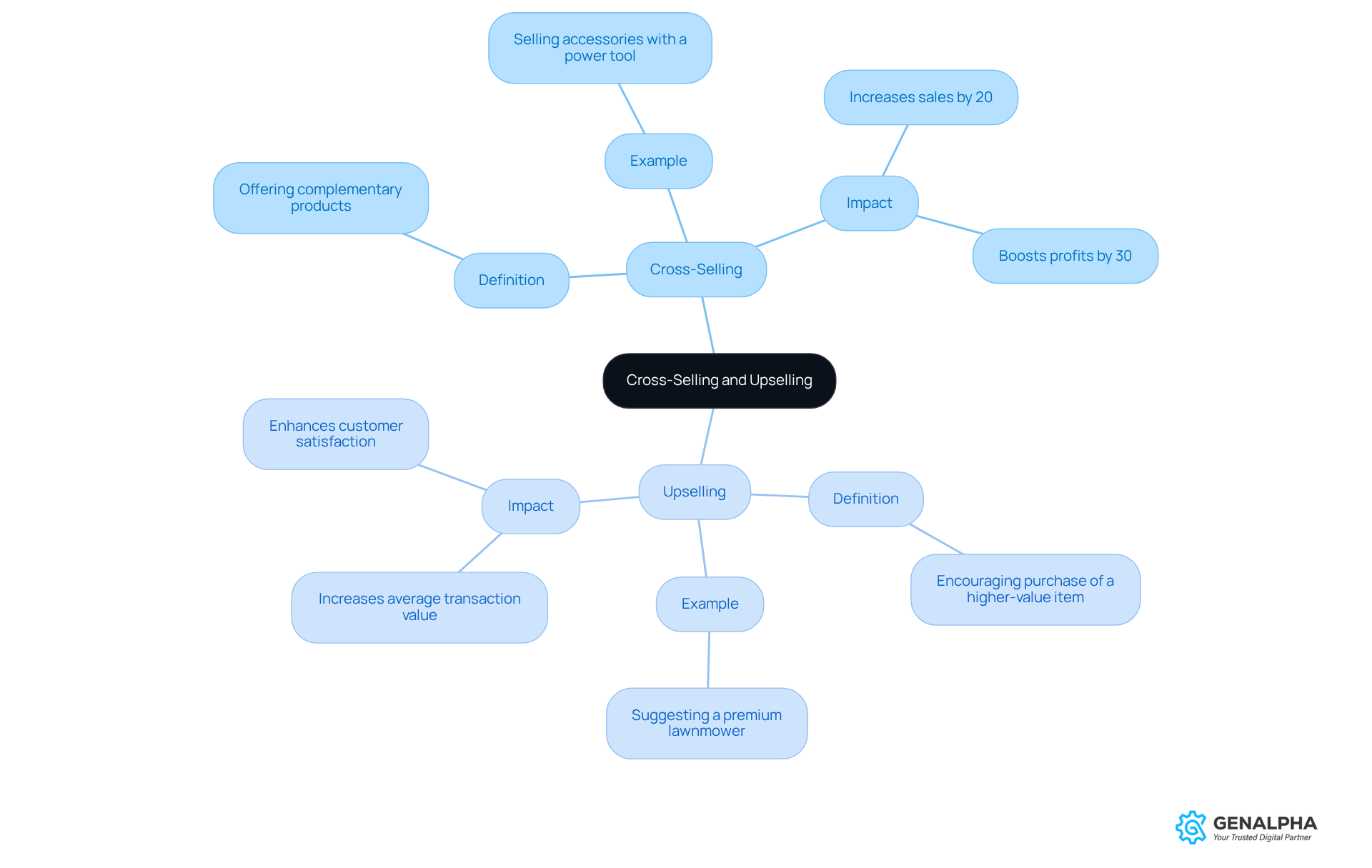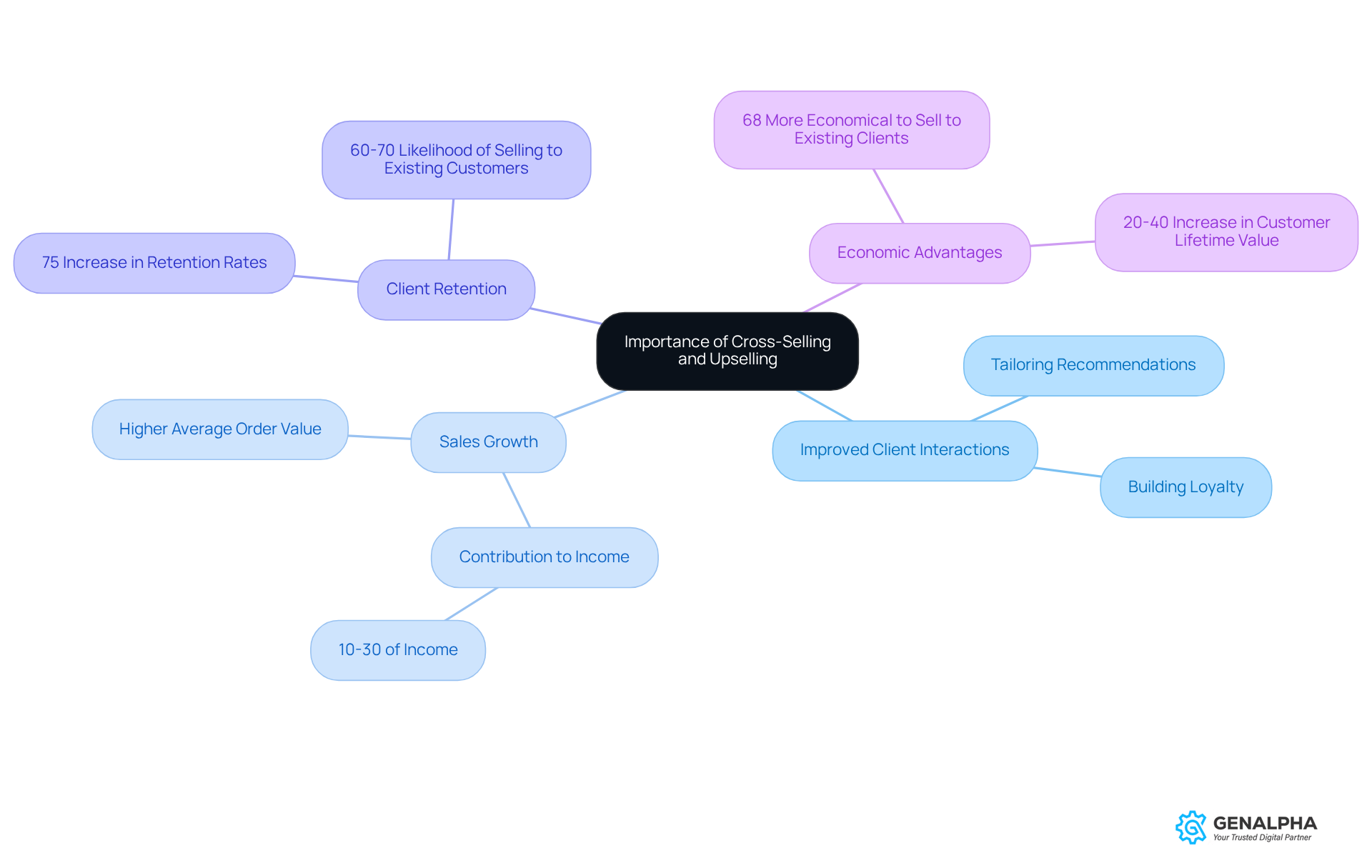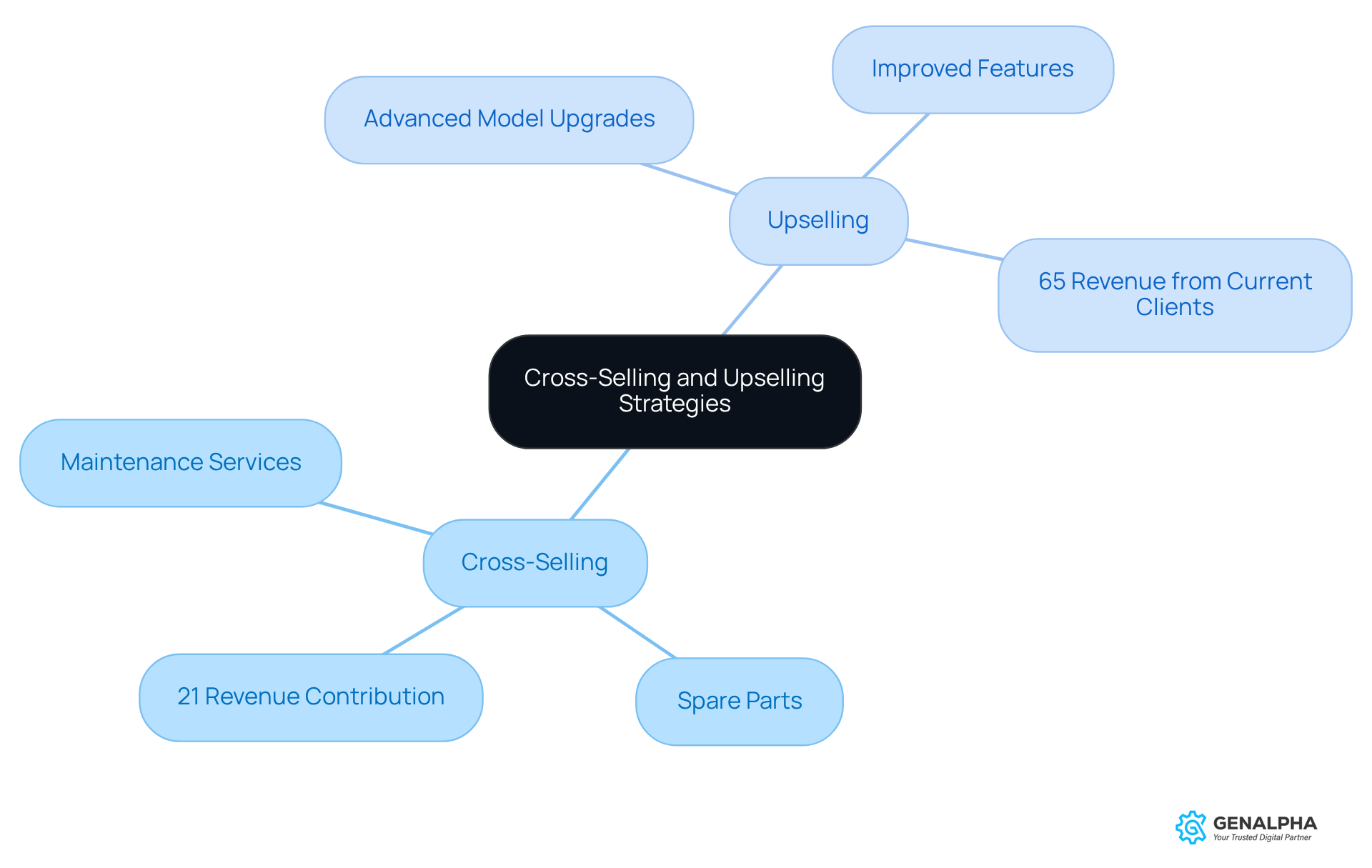Overview
Have you ever been in a store and found yourself tempted by a suggestion for a complementary product? That’s the magic of cross-selling and upselling! These strategies aren’t just buzzwords; they’re vital for manufacturers looking to enhance customer experiences and boost revenue. By recommending products that go hand-in-hand or offering higher-value alternatives, businesses can really make a difference.
For instance, research shows that when these strategies are effectively implemented, sales can jump by a whopping 20-30%! Plus, they can improve client retention rates by an impressive 75%. Isn’t that something to think about? It’s clear that cross-selling and upselling play a crucial role in building long-term customer relationships and driving business growth.
So, why not take a moment to consider how you can incorporate these techniques into your sales approach? The benefits are there, just waiting to be tapped into. Let’s start a conversation about how we can make the most of these strategies together!
Introduction
Have you ever thought about how understanding sales strategies can really change the game for manufacturers trying to boost their revenue? Cross-selling and upselling might sound like just trendy terms, but they’re actually powerful techniques that can enhance the customer experience and significantly increase profits. The real challenge, though, is figuring out how to implement these strategies without overwhelming your clients. So, how can manufacturers do this?
In this article, we’ll dive into the details of cross-selling and upselling. We’ll explore what they mean, why they’re important, and how they can be practically applied in the manufacturing sector. By the end, you’ll see how these tactics can lead to sustained growth and stronger relationships with your clients. Let’s get started!
Define Cross-Selling and Upselling
Understanding what is is essential, as they are key strategies that can significantly boost revenue by enhancing the buying experience for clients. Ever been in a store and found yourself buying more than you planned? That’s cross-selling in action! It’s all about suggesting additional products or services that complement what someone is already buying. For instance, if you’re picking up a power tool, the retailer might suggest some handy accessories like drill bits or safety gear. This not only broadens your options but can also lead to a significant increase in sales—studies show effective cross-selling can boost sales by 20% and overall profits by 30%!
Now, let’s talk about upselling. This is when you’re encouraged to opt for a pricier version of a product or an upgrade. Imagine you’re eyeing a basic lawnmower, but the salesperson nudges you to consider a premium model with all the bells and whistles. Not only does this enhance your experience, but it also increases the average transaction value. After all, many clients are willing to spend a bit more on items that offer greater value. Research indicates that companies are 60% to 70% more likely to sell to a current client, which really highlights how effective upselling can be, especially when it aligns with what the client initially wanted.
Recently, there’s been a shift in B2B transactions that emphasizes personalization in both strategies. Industry leaders are advocating for tailored suggestions that match client needs, which boosts satisfaction and loyalty. Take Amazon, for example—they’ve nailed it with their 'frequently bought together' prompts, which have led to a whopping 35% increase in revenue since their launch in 2006. Plus, CRM software can streamline cross-promotion and sales strategies, helping businesses leverage client information to enhance their selling processes. Understanding what is cross selling and upselling is crucial for producers aiming to refine their selling methods and elevate client engagement. So, how can you implement these strategies in your business today?

Explain the Importance of Cross-Selling and Upselling
Producers and suppliers should know what is cross selling and upselling as these are essential tactics. They not only improve client interactions but also boost sales growth. Imagine suggesting complementary products to your clients—this approach can provide comprehensive solutions that meet their needs, fostering loyalty and encouraging repeat purchases. In fact, effective strategies for what is cross selling and upselling can account for 10-30% of a company’s income! Plus, promoting higher-value purchases can significantly elevate average order amounts, which is crucial in today’s competitive markets.
One of the biggest advantages of these strategies is leveraging established client connections. Did you know that selling products to current clients is 60%-70% more likely than selling to new ones? Additionally, increasing sales to existing clients is 68% more economical than acquiring new ones. This really underscores the importance of nurturing those connections! According to Gartner, businesses that understand what is cross selling and upselling can see an impressive 75% rise in client retention rates.
In the manufacturing industry, where client retention is key, understanding what is cross selling and upselling techniques can lead to sustained growth and profitability. Industry specialists highlight that these strategies not only boost revenue but also enhance client satisfaction, creating a win-win situation for both buyers and sellers. By understanding consumer preferences and tailoring recommendations, manufacturers can position themselves as trusted partners, driving long-term success.
However, it’s important to approach these sales tactics with care. As Krunal Vaghasiya points out, these techniques should be avoided when clients are clear about their needs. This balanced approach allows manufacturers to while maintaining strong connections with their clients. So, how can you start implementing these tactics in your own business?

Provide Examples of Cross-Selling and Upselling
In the manufacturing sector, knowing what is cross selling and upselling is essential for driving revenue and keeping clients happy. Imagine a company that specializes in industrial machinery. They might cross-sell vital maintenance services or spare parts, which not only helps ensure the longevity of the equipment but also generates ongoing revenue. This strategy and fosters a long-term relationship between the manufacturer and the client. Did you know that cross-selling accounts for 21% of company revenues? That’s according to a survey of 1,400 salespeople by HubSpot, highlighting just how important it is in revenue generation.
Now, think about a supplier of construction machinery who encourages clients to upgrade from a standard excavator to a more advanced model. This new model might come with improved features like greater lifting capacity or cutting-edge technology. This approach not only meets the evolving demands of clients but also significantly boosts the distributor's sales performance. After all, current clients represent 65% of revenue, which emphasizes the importance of nurturing these connections for upselling opportunities.
Case studies reveal that companies employing these strategies can see substantial increases in average order values and client loyalty. For instance, businesses that provide tailored suggestions based on client information often report conversion rate boosts of up to 40%. Moreover, industry leaders emphasize that building trust and rapport is crucial for effective promotion, as it strengthens client relationships and increases the likelihood of further transactions. As Justin Zappulla wisely states, 'The trick, however, is demonstrating what is cross selling and upselling and how they provide mutual benefits for both buyers and sellers.' By strategically positioning their offerings, manufacturers can maximize sales while ensuring they meet their customers' specific needs.

Conclusion
Understanding the nuances of cross-selling and upselling is crucial for manufacturers who want to boost their revenue and keep their customers happy. These strategies not only make the buying experience better for clients but also act as powerful tools for driving growth. By suggesting complementary products or encouraging upgrades, manufacturers can significantly increase their sales and build long-lasting relationships with their clients.
Have you ever considered how effective cross-selling can lead to a notable increase in sales? Studies show potential boosts of 20% in sales and 30% in profits. And upselling? It can elevate average transaction values, as many clients are willing to spend more for enhanced features or services. Personalizing these approaches is key; tailored recommendations based on client preferences can enhance satisfaction and loyalty. This makes it essential for manufacturers to leverage their existing client relationships.
Incorporating these strategies into your business practices not only positions you as a trusted partner but also drives sustained growth and profitability. Embracing cross-selling and upselling thoughtfully can lead to impressive increases in client retention and revenue. So, why not explore these tactics further? By ensuring you meet your clients' needs, you can maximize your own business potential.
Frequently Asked Questions
What is cross-selling?
Cross-selling is a sales strategy where additional products or services that complement a customer's current purchase are suggested. For example, if someone is buying a power tool, they might be offered accessories like drill bits or safety gear.
What are the benefits of cross-selling?
Effective cross-selling can significantly boost sales—studies show it can increase sales by 20% and overall profits by 30%.
What is upselling?
Upselling is a strategy that encourages customers to opt for a more expensive version of a product or an upgrade. For instance, a salesperson might suggest a premium lawnmower instead of a basic model.
How does upselling benefit businesses?
Upselling can increase the average transaction value and is particularly effective because research indicates that companies are 60% to 70% more likely to sell to current clients.
How has personalization impacted cross-selling and upselling in B2B transactions?
There has been a shift towards personalization in B2B transactions, with industry leaders advocating for tailored suggestions that match client needs, which enhances customer satisfaction and loyalty.
Can you provide an example of successful cross-selling?
Amazon's 'frequently bought together' prompts are an example of successful cross-selling, which has led to a 35% increase in revenue since its launch in 2006.
How can businesses implement cross-selling and upselling strategies?
Businesses can implement these strategies by leveraging client information through CRM software to streamline cross-promotion and enhance their selling processes.




